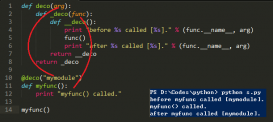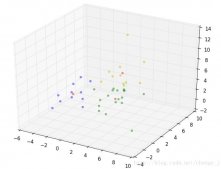首先这是VGG的结构图,VGG11则是红色框里的结构,共分五个block,如红框中的VGG11第一个block就是一个conv3-64卷积层:

一,写VGG代码时,首先定义一个 vgg_block(n,in,out)方法,用来构建VGG中每个block中的卷积核和池化层:

n是这个block中卷积层的数目,in是输入的通道数,out是输出的通道数
有了block以后,我们还需要一个方法把形成的block叠在一起,我们定义这个方法叫vgg_stack:
|
1
2
3
4
5
6
7
8
9
|
def vgg_stack(num_convs, channels): # vgg_net = vgg_stack((1, 1, 2, 2, 2), ((3, 64), (64, 128), (128, 256), (256, 512), (512, 512))) net = [] for n, c in zip(num_convs, channels): in_c = c[0] out_c = c[1] net.append(vgg_block(n, in_c, out_c)) return nn.Sequential(*net) |
右边的注释
vgg_net = vgg_stack((1, 1, 2, 2, 2), ((3, 64), (64, 128), (128, 256), (256, 512), (512, 512)))
里,(1, 1, 2, 2, 2)表示五个block里,各自的卷积层数目,((3, 64), (64, 128), (128, 256), (256, 512), (512, 512))表示每个block中的卷积层的类型,如(3,64)表示这个卷积层输入通道数是3,输出通道数是64。vgg_stack方法返回的就是完整的vgg11模型了。
接着定义一个vgg类,包含vgg_stack方法:
|
1
2
3
4
5
6
7
8
9
10
11
12
13
14
15
16
|
#vgg类class vgg(nn.Module): def __init__(self): super(vgg, self).__init__() self.feature = vgg_net self.fc = nn.Sequential( nn.Linear(512, 100), nn.ReLU(True), nn.Linear(100, 10) ) def forward(self, x): x = self.feature(x) x = x.view(x.shape[0], -1) x = self.fc(x) return x |
最后:
net = vgg() #就能获取到vgg网络
那么构建vgg网络完整的pytorch代码是:
|
1
2
3
4
5
6
7
8
9
10
11
12
13
14
15
16
17
18
19
20
21
22
23
24
25
26
27
28
29
30
31
32
33
34
35
36
37
38
39
|
def vgg_block(num_convs, in_channels, out_channels): net = [nn.Conv2d(in_channels, out_channels, kernel_size=3, padding=1), nn.ReLU(True)] for i in range(num_convs - 1): # 定义后面的许多层 net.append(nn.Conv2d(out_channels, out_channels, kernel_size=3, padding=1)) net.append(nn.ReLU(True)) net.append(nn.MaxPool2d(2, 2)) # 定义池化层 return nn.Sequential(*net) # 下面我们定义一个函数对这个 vgg block 进行堆叠def vgg_stack(num_convs, channels): # vgg_net = vgg_stack((1, 1, 2, 2, 2), ((3, 64), (64, 128), (128, 256), (256, 512), (512, 512))) net = [] for n, c in zip(num_convs, channels): in_c = c[0] out_c = c[1] net.append(vgg_block(n, in_c, out_c)) return nn.Sequential(*net) #确定vgg的类型,是vgg11 还是vgg16还是vgg19vgg_net = vgg_stack((1, 1, 2, 2, 2), ((3, 64), (64, 128), (128, 256), (256, 512), (512, 512)))#vgg类class vgg(nn.Module): def __init__(self): super(vgg, self).__init__() self.feature = vgg_net self.fc = nn.Sequential( nn.Linear(512, 100), nn.ReLU(True), nn.Linear(100, 10) ) def forward(self, x): x = self.feature(x) x = x.view(x.shape[0], -1) x = self.fc(x) return x #获取vgg网络net = vgg() |
基于VGG11的cifar10训练代码:
|
1
2
3
4
5
6
7
8
9
10
11
12
13
14
15
16
17
18
19
20
21
22
23
24
25
26
27
28
29
30
31
32
33
34
35
36
37
38
39
40
41
42
43
44
45
46
47
48
49
50
51
52
53
54
55
56
57
58
59
60
61
62
63
64
65
66
67
68
69
70
71
72
73
74
75
76
77
78
79
80
81
82
83
84
85
86
87
88
89
90
91
92
93
94
95
96
97
98
99
100
101
102
103
104
105
106
107
108
109
110
111
112
113
114
115
116
117
118
119
120
121
122
123
124
125
126
127
128
129
130
131
|
import sysimport numpy as npimport torchfrom torch import nnfrom torch.autograd import Variablefrom torchvision.datasets import CIFAR10import torchvision.transforms as transforms def vgg_block(num_convs, in_channels, out_channels): net = [nn.Conv2d(in_channels, out_channels, kernel_size=3, padding=1), nn.ReLU(True)] for i in range(num_convs - 1): # 定义后面的许多层 net.append(nn.Conv2d(out_channels, out_channels, kernel_size=3, padding=1)) net.append(nn.ReLU(True)) net.append(nn.MaxPool2d(2, 2)) # 定义池化层 return nn.Sequential(*net) # 下面我们定义一个函数对这个 vgg block 进行堆叠def vgg_stack(num_convs, channels): # vgg_net = vgg_stack((1, 1, 2, 2, 2), ((3, 64), (64, 128), (128, 256), (256, 512), (512, 512))) net = [] for n, c in zip(num_convs, channels): in_c = c[0] out_c = c[1] net.append(vgg_block(n, in_c, out_c)) return nn.Sequential(*net) #vgg类class vgg(nn.Module): def __init__(self): super(vgg, self).__init__() self.feature = vgg_net self.fc = nn.Sequential( nn.Linear(512, 100), nn.ReLU(True), nn.Linear(100, 10) ) def forward(self, x): x = self.feature(x) x = x.view(x.shape[0], -1) x = self.fc(x) return x # 然后我们可以训练我们的模型看看在 cifar10 上的效果def data_tf(x): x = np.array(x, dtype='float32') / 255 x = (x - 0.5) / 0.5 x = x.transpose((2, 0, 1)) ## 将 channel 放到第一维,只是 pytorch 要求的输入方式 x = torch.from_numpy(x) return x transform = transforms.Compose([transforms.ToTensor(), transforms.Normalize(mean=(0.5, 0.5, 0.5), std=(0.5, 0.5, 0.5)), ])def get_acc(output, label): total = output.shape[0] _, pred_label = output.max(1) num_correct = (pred_label == label).sum().item() return num_correct / total def train(net, train_data, valid_data, num_epochs, optimizer, criterion): if torch.cuda.is_available(): net = net.cuda() for epoch in range(num_epochs): train_loss = 0 train_acc = 0 net = net.train() for im, label in train_data: if torch.cuda.is_available(): im = Variable(im.cuda()) label = Variable(label.cuda()) else: im = Variable(im) label = Variable(label) # forward output = net(im) loss = criterion(output, label) # forward optimizer.zero_grad() loss.backward() optimizer.step() train_loss += loss.item() train_acc += get_acc(output, label) if valid_data is not None: valid_loss = 0 valid_acc = 0 net = net.eval() for im, label in valid_data: if torch.cuda.is_available(): with torch.no_grad(): im = Variable(im.cuda()) label = Variable(label.cuda()) else: with torch.no_grad(): im = Variable(im) label = Variable(label) output = net(im) loss = criterion(output, label) valid_loss += loss.item() valid_acc += get_acc(output, label) epoch_str = ( "Epoch %d. Train Loss: %f, Train Acc: %f, Valid Loss: %f, Valid Acc: %f, " % (epoch, train_loss / len(train_data), train_acc / len(train_data), valid_loss / len(valid_data), valid_acc / len(valid_data))) else: epoch_str = ("Epoch %d. Train Loss: %f, Train Acc: %f, " % (epoch, train_loss / len(train_data), train_acc / len(train_data))) # prev_time = cur_time print(epoch_str) if __name__ == '__main__': # 作为实例,我们定义一个稍微简单一点的 vgg11 结构,其中有 8 个卷积层 vgg_net = vgg_stack((1, 1, 2, 2, 2), ((3, 64), (64, 128), (128, 256), (256, 512), (512, 512))) print(vgg_net) train_set = CIFAR10('./data', train=True, transform=transform, download=True) train_data = torch.utils.data.DataLoader(train_set, batch_size=64, shuffle=True) test_set = CIFAR10('./data', train=False, transform=transform, download=True) test_data = torch.utils.data.DataLoader(test_set, batch_size=128, shuffle=False) net = vgg() optimizer = torch.optim.SGD(net.parameters(), lr=1e-1) criterion = nn.CrossEntropyLoss() #损失函数为交叉熵 train(net, train_data, test_data, 50, optimizer, criterion) torch.save(net, 'vgg_model.pth') |
结束后,会出现一个模型文件vgg_model.pth
二,然后网上找张图片,把图片缩成32x32,放到预测代码中,即可有预测结果出现,预测代码如下:
|
1
2
3
4
5
6
7
8
9
10
11
12
13
14
15
16
17
18
19
20
21
22
23
24
25
26
27
28
29
30
31
32
33
34
35
36
37
38
39
40
41
42
43
44
45
|
import torchimport cv2import torch.nn.functional as Ffrom vgg2 import vgg ##重要,虽然显示灰色(即在次代码中没用到),但若没有引入这个模型代码,加载模型时会找不到模型from torch.autograd import Variablefrom torchvision import datasets, transformsimport numpy as np classes = ('plane', 'car', 'bird', 'cat', 'deer', 'dog', 'frog', 'horse', 'ship', 'truck')if __name__ == '__main__': device = torch.device('cuda' if torch.cuda.is_available() else 'cpu') model = torch.load('vgg_model.pth') # 加载模型 model = model.to(device) model.eval() # 把模型转为test模式 img = cv2.imread("horse.jpg") # 读取要预测的图片 trans = transforms.Compose( [ transforms.ToTensor(), transforms.Normalize(mean=(0.5, 0.5, 0.5), std=(0.5, 0.5, 0.5)) ]) img = trans(img) img = img.to(device) img = img.unsqueeze(0) # 图片扩展多一维,因为输入到保存的模型中是4维的[batch_size,通道,长,宽],而普通图片只有三维,[通道,长,宽] # 扩展后,为[1,1,28,28] output = model(img) prob = F.softmax(output,dim=1) #prob是10个分类的概率 print(prob) value, predicted = torch.max(output.data, 1) print(predicted.item()) print(value) pred_class = classes[predicted.item()] print(pred_class) # prob = F.softmax(output, dim=1) # prob = Variable(prob) # prob = prob.cpu().numpy() # 用GPU的数据训练的模型保存的参数都是gpu形式的,要显示则先要转回cpu,再转回numpy模式 # print(prob) # prob是10个分类的概率 # pred = np.argmax(prob) # 选出概率最大的一个 # # print(pred) # # print(pred.item()) # pred_class = classes[pred] # print(pred_class) |
缩成32x32的图片:

运行结果:

以上这篇pytorch VGG11识别cifar10数据集(训练+预测单张输入图片操作)就是小编分享给大家的全部内容了,希望能给大家一个参考,也希望大家多多支持服务器之家。
原文链接:https://blog.csdn.net/u014453898/article/details/91380837












